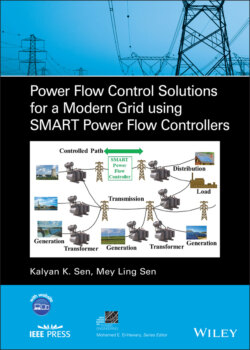Читать книгу Power Flow Control Solutions for a Modern Grid Using SMART Power Flow Controllers - Kalyan K. Sen - Страница 2
Table of Contents
Оглавление1 Cover
2 Series Page
3 Title Page
4 Copyright Page
5 Dedication Page
6 Authors’ Biographies
7 Foreword
8 Nomenclature
9 Preface
10 Acknowledgments
11 About the Companion Website
12 1 Smart Controllers 1.1 Why is a Power Flow Controller Needed? 1.2 Traditional Power Flow Control Concepts 1.3 Modern Power Flow Control Concepts 1.4 Cost of a Solution 1.5 Independent Active and Reactive PFCs 1.6 SMART Power Flow Controller (SPFC) 1.7 Discussion
13 2 Power Flow Control Concepts 2.1 Power Flow Equations for a Natural or Uncompensated Line 2.2 Power Flow Equations for a Compensated Line 2.3 Implementation of Power Flow Control Concepts 2.4 Interline Power Flow Concept 2.5 Figure of Merits Among Various PFCs 2.6 Comparison Between Shunt‐Compensating Reactance and Series‐Compensating Reactance 2.7 Calculation of RPI, LI, and APR for a PAR (sym), a PAR (asym), a RR, and an IR in a Lossy Line 2.8 Sen Index of a PFC
14 3 Modeling Principles 3.1 The Modeling in EMTP 3.2 Vector Phase‐Locked Loop (VPLL) 3.3 Transmission Line Steady‐State Resistance Calculator 3.4 Simulation of an Independent PFC, Integrated in a Two‐Generator/Single‐Line Power System Network
15 4 Transformer‐Based Power Flow Controllers 4.1 Voltage‐Regulating Transformer (VRT) 4.2 Phase Angle Regulator (PAR)
16 5 Mechanically‐Switched Voltage Regulators and Power Flow Controllers 5.1 Shunt Compensation 5.2 Series Compensation
17 6 Sen Transformer 6.1 Existing Solutions 6.2 Desired Solution 6.3 Comparison Among the VRT, PAR, UPFC, and ST 6.4 Multiline Sen Transformer 6.5 Flexible Operation of the ST 6.6 ST with a Shunt‐Compensating Voltage 6.7 Limited Angle Operation of the ST with Shunt‐Compensating Voltages 6.8 MST with Shunt‐Compensating Voltages 6.9 Generalized Sen Transformer 6.10 Summary
18 Appendix A: Miscellaneous A.1 Three‐Phase Balanced Voltage, Current, and Power A.2 Symmetrical Components A.3 Separation of Positive‐, Negative‐, and Zero‐Sequence Components in a Multiple Frequency Composite Variable A.4 Three‐Phase Unbalanced Voltage, Current, and Power A.5 d‐q Transformation (3‐Phase System, Transformed into d‐q axes; d‐axis Is the Active Component and q‐axis Is the Reactive Component) A.6 Fourier Analysis A.7 Adams‐Bashforth Numerical Integration Formula
19 Appendix B: Power Flow Equations in a Lossy Line B.1 Power Flow Equations for a Natural or Uncompensated Line B.2 Power Flow Equations for a Compensated Line B.3 Descriptions of the Examples in Chapter 2
20 Appendix C: Modeling of the Sen Transformer in PSS ®E C.1 Sen Transformer C.2 Modeling with Two Transformers in Series C.3 Relating the Sen Transformer with the PSS®E Model C.4 Chilean Case Study C.5 Limitations – PSS®E Two‐Transformer Model C.6 Conclusion
21 References Further Reading
22 Index
23 Books in the IEEE Press Series on Power and Engineering
24 End User License Agreement
